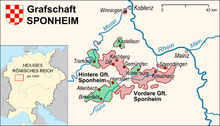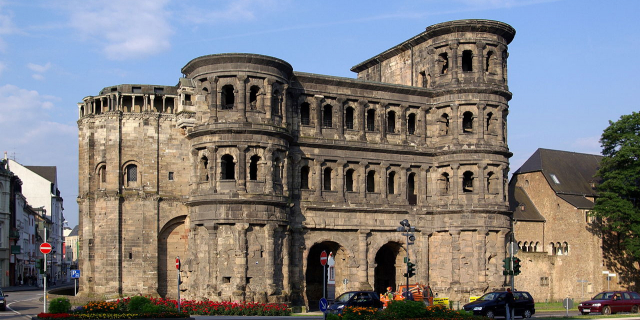Traben-Trarbach
Traben-Trarbach (German pronunciation: [ˌtraːbn̩ ˈtraːɐ̯bax]) on the Middle Moselle is a town in the Bernkastel-Wittlich district in Rhineland-Palatinate, Germany. It is the seat of the like-named Verbandsgemeinde and a state-recognized climatic spa (Luftkurort). The city lies in the so-called "Valley of Dawn".
 Aacher Hof, plaque inscription: “Urkundlich 830 erwähnt als Lehen an das Aachener Marienstift durch Ludwig den Frommen.” (see main text)
Aacher Hof, plaque inscription: “Urkundlich 830 erwähnt als Lehen an das Aachener Marienstift durch Ludwig den Frommen.” (see main text)As early as 830, the Aacher Hof (estate) had a documentary mention. Emperor Louis the Pious, Charlemagne’s son, donated Traben with all its rights and privileges, and its appurtenances, namely Litzig, Rißbach, Irmenach and Beuren, to the minster at Aachen (Aachen Foundation of Mary), where German kings were crowned.
In the 17th century, the town was part of what was then known as Rhenish Franconia, a strategic area fought over by France and the Holy Roman Empire. Seized by France in the 1683-1684 War of the Reunions, Traben was the location for the new fortress of Mont-Royal, constructed by Vauban, the leading military engineer of the period.[1] The main ramparts were 30 metres high and three kilometres long, with space for 12,000 troops; despite the enormous cost, it was demolished when the French withdrew following the 1697 Treaty of Ryswick and only the lower foundations are visible today.[2]
 County of Sponheim (c. 1804)
County of Sponheim (c. 1804)All today’s Stadtteile – with the exception of a part of Kautenbach – belonged to the Hintere (English: rear, back, i.e. hinterland; Upper) County of Sponheim, whose main centre was Trarbach. After the comital family of Sponheim died out, the inheriting landholders formed the County into a Palatine-Badish condominium and had their residences elsewhere in the County, namely in Birkenfeld and Kastellaun. Trarbach was also the seat of a Palatine oberamt, the Oberamt Trarbach.
In 1816, the area around Trarbach was annexed to Prussia, with Trarbach itself becoming the seat of a Bürgermeisterei (“Mayoralty”). Against expectations, however, Zell, rather than Trarbach, was made the district seat, even though the latter was the biggest place in the new District of Zell. The Bürgermeisterei of Trarbach was dissolved in 1884, and Trarbach no longer belonged to any Bürgermeisterei. It was, rather, administered thereafter in personal union with the new Bürgermeisterei of Traben. In 1898, the first bridge was built between the two centres, one built to plans drawn up by Bruno Möhring. This bridge, which was blown up in the dying days of the Second World War in 1945, was at the same time also the first roadbridge between Bernkastel and Koblenz. The next bridges were built only in 1924, in Cochem, and between 1951 and 1953 in Zell. In the late 19th century, Traben and Trarbach were also, together with Reichenhall, the first municipalities in Germany that, instead of having gaslamps, installed electric street lighting from the Edison Company (today AEG), although the odd stretch of street in Berlin had already been outfitted with electric lighting. In 1904, the municipality of Traben and the town of Trarbach merged to become the town of Traben-Trarbach. The next changes came on 7 June 1969, when the municipalities of Kautenbach and Wolf were amalgamated with Traben-Trarbach. One year later, the Verbandsgemeinde of Traben-Trarbach was newly formed. It has its administrative seat in the town; Traben-Trarbach is a member municipality of the Verbandsgemeinde, a kind of collective municipality.
Because they belonged to the “Hinder” County of Sponheim, the Reformation was introduced into Traben and Trarbach, with the town remaining even today mainly Evangelical, even though newcomers, particularly in the 19th and 20th centuries, have raised the Catholic share of the population markedly. The Evangelical Church's leadership in the Hinder County of Sponheim was at first exercised from the Birkenfeld chancellery. Then, in 1672, a Hinder-Sponheim Lutheran consistory was instituted, whose duties were transferred to the consistory in Zweibrücken in 1776.
In 1818, the Synod of Trarbach was established, whose seat remained in Trarbach until 1972. Because of its size – the synod encompassed the districts of Bernkastel, Zell and Trier – this was divided in 1825. Curiously, the outlying centre of Wolf belonged until 1892 to the Synod of Trier, which itself, until 1843, bore the name “Synod of Wolf” because that was the superintendent's home.






























Add new comment